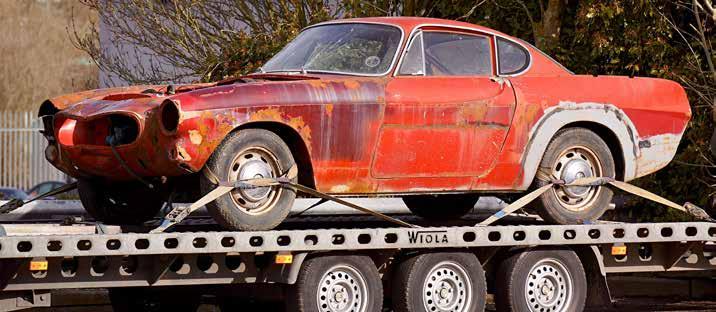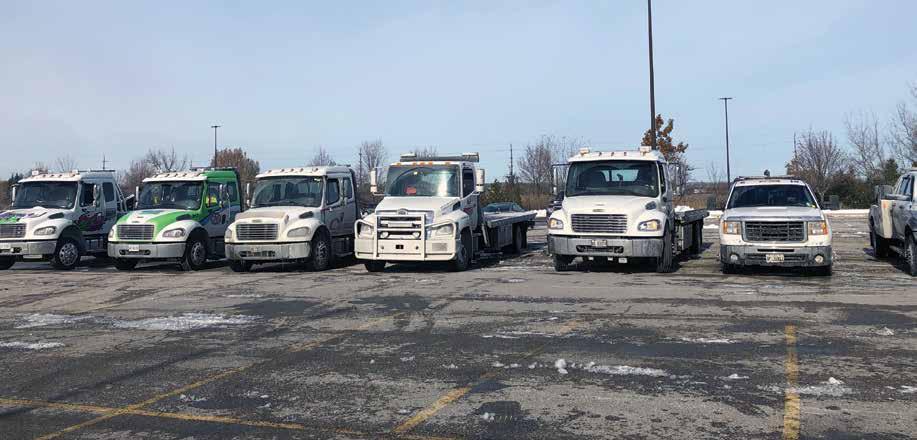
9 minute read
AFTERMARKET AFFAIRS
SCANNING THE SCENE
How the aftermarket’s value is being drained by high-tech tricks
BY ELIZABETH SARGEANT
The value of undrivable vehicles could go up significantly if auto parts customers had access to the same vehicle scanning technology given to auto repair facilities. For towing professionals, this means that the value of their specialized cargo is not being realized to its full potential.
“Because there’s no Interchange telling us what will work and what won’t work in other vehicles, recyclers aren’t taking these parts off of the car. There is a labour cost, and if there is no chance of recovering that by selling parts, then it is a dead cost,” says Pat Ryan, a services consultant at auto paint firm Akzo Nobel.
It is a problem that Ryan first encountered in 2016.
At the time, he wanted to do a project in which he and his coworkers would use the same type of technology that body shops use to scan cars in recyclers inventory, in order to determine which of the electronic components were still usable and resellable in a novel and efficient way.
“We embarked on this project and ended up hitting a very big dead end. A lot of these components were ‘married’ to the car,” says Ryan. “When an auto part is married to the car, its technology is tied to the vehicle’s VIN number, leaving it virtually useless when reattached to a different vehicle.”
While features such as door mirrors, tail lights, and lane departure warning modules seem to be easily reintegrated into new vehicles - ECM, PCM, and other core electronic components can not. For auto recyclers, this is nothing short of a disaster. “Every car being recycled has at least four or five of these major components alongside a whole series of micro-component. Some of them are marriable and some of them are not,” Ryan explained.
According to Ryan, this isn’t only hurtful to recycler’s businesses, but to the environment.
“It’s a tremendous environmental issue. We’re landfilling a whole bunch of stuff that really is recyclable so at this point in time without the Interchange and not being able to take these modules back to their original state it really holding us back.”
As secondary beneficiaries of rises in auto parts prices, towing professionals could play a role in pushing for a resolution to the issue.
“If industry stakeholders were to fund a project to solve this issue, the solution would be ahead.”
BUILDING TRUST
Concerned about your advice to clients being misconstrued?
When towing and recovery professionals are criticized, it is often because they are accused of pushing drivers to visit repair facilities with whom they have a kickback arrangement. While not unheard of, not every recommendation provided is done so for financial reasons. Even towing professionals with agreements with auto repair facilities may seek to provide sincere advice.
One good way for towing professionals to avoid accusations of taking advantage of drivers is to provide information that is true, and not about any particular facility.
Here are some talking points towing and recovery professionals may find to be worth keeping in mind. What you can tell them:
1
It is their legal right to choose which collision repair facility, just as it is their right to choose whichever towing service they would like to service their vehicle.
Insurance companies do provide recommendations to drivers about which repair facility would be appropriate to seek the services of.
3 2
Insurance companies recommendations can be based on many factors, not all of them related to the quality-of-service the consumer receives.
Partner businesses are usually chosen for reputation, timeliness, quality-of -repairs, ease-of-doing business with the insurer and ability to perform repairs at a discount in return for access to higher volumes of business.
4
5
While some auto insurers may describe repairs performed at non-recommended locations as being not guaranteed by the insurer, most auto repair providers do guarantee all procedures for the lifetime of a vehicle.
Many vehicle manufacturers supply lists of auto repair facilities they have certified to repair their brands of vehicle based on their specified repair procedures.
6
Operator Todd Burgess, 53, was struck and killed in the line of duty on Nov. 7, 2019

RALLYING
FOR REMEMBRANCE Why Canada’s Tow Pros Must Stand Together
BY GIDEON SCANLON
There is something wrong with the world. Until the towing professional community rallied together, Canada’s public news outlet’s online platform had given more attention to an unfortunate bear than the tragic loss of a towing professional and community leader.
On November 13, 2019, a black bear was struck by a tow truck driver near Owen Sound, Ont. The news was reported by the CBC.ca in a November 16, 2019 article—two days later.
In it, an Owen Sound Police community service reporter is quoted delivering the sad news. “When the police arrived on scene, they realized that the bear has succumbed to its injuries as a result of the collision.”
On November 7, 2019, a driver struck and killed Todd Burgess, a towing professional working on an infamously dangerous stretch of road near Scugog, Ontario.
The CBC website story on Burgess was posted on November 13, 2019—almost a full week after his death.
The crux of the story wasn’t actually his death, but his funeral. During the service, more than 200 fellow industry workers had participated in a ride-through to draw attention
to the dangers faced by towing professionals.
My point isn’t to criticize the CBC for its coverage of the towing community. In fact, as news outlets go, it covers these stories well, fairly and with a balance not seen elsewhere. In fact, CBC radio reached out to us for advice on covering the issues that plague roadside operators, and indicated a desire to highlight the issue—something no other publication did.
Nor am I foolish enough to throw stones in my own glass house. We also held back on running the story of Todd’s death until it was reasonable to assume his close friends or family members would have been informed.
My point is that there is a lack of interest in covering stories about the dangers facing members of the auto aftermarket figures. There is a reader interest in stories where tow truck drivers strike photogenic animals.
The towing community members who came out to raise awareness of the dangers facing roadside recovery vehicle worker s managed to redress this imbalance.
They should be applauded.
Only by rallying together will the towing be able to break through the public’s indifference.
ON YOUR MARK
PTAO president Mark Graves on uniting the aftermarket behind a common purpose
It has been a productive—if difficult— year for the Provincial Towing Association of Ontario’s president, Mark Graves.
For one thing, press coverage of the towing industry in Ontario has paid special attention to the actions of a small group of criminals tenuously connected to the collision sector. While this might not sound like fertile ground for improving the towing industry’s relationship with the general public, members of the organization— himself included—had accomplished something rather impressive.
In each major story covering incidents related to this story, PTAO members had managed to share one key point with listeners—that these crimes victimized the vast majority of members of the towing profession—more so than any other group.
For another, tow professional Todd Burgess was killed just outside Oshawa, Ontario, while performing a roadside recovery operation. While the incident, naturally, struck close to home for many PTAO members, the accident also struck a chord with the general public. Unlike in many other situations, the news media began to cover the issue as if a person—rather than a member of a high risk profession—had died.
Graves recently sat down with Canadian Towing Professional to discuss how the towing industry could work more effectively with other sectors of the automotive aftermarket .
Canadian Towing Professional: Tow operators have found themselves painted in a bad light and the result of the malpractice of a few bad eggs. The coverage of these bad actors often has a rippling effect for the industries. What are the biggest public misconceptions about tow operators?
Mark Graves: Well, the only thing that is ever put out through the news is always the bad stuff. So there is a lot of fear and worry about what happens when you break down on the road.
The vast majority of towers are good company and good people. They are in this business to helpt he public. They want to help you, even if a few bad stories can make that hard to believe!
CTP: As we begin a new decade, what would you say was the biggest change that has faced tow professionals—in relation to their work with other businesses in the automotive aftermarket?
MG: I don’t know that there has been any change one way or another.
There has always been a symbiotic relationship between garages, towing companies and auto bodyshops. They have worked together for years, and I think we can build on that to make the roads safer for everyone.
CTP: Could each of these sectors work a little more effectively with one another?
MG: I find that all of the industries are very siloed. We could get a better working relationship and solve common problems collectively. We see each group as fighting their own battles right now, but if we worked together and fought collectively, we might have more success.
If the organizations and associations related to towing, collision repair and auto garages could manage to get groups to come together., we could get a better working relationship. That would be in order to solve common problems.
CTP: What would you say was the biggest of those shared problems? MG: I’m not really sure. It is something that we have to sit down and discuss.
We should sit down and figure out the issues collision shops are having. We know we all have issues with insurance companies--what they want to pay, and how they want to pay.
Each company wants its own type of billing and infrastructure to be the one that gets followed. If we could work with the bodyshops to come up with some cohesiveness in the billing structure that works with the insurance companies, it would mean we all would get paid faster.
CTP: What is PTAO focusing on for 2020?
MG: We are working with a lot of different groups and organizations, working on developing ways that everything can be standardized—practices and safety procedures.
Our priority is always our operators. We’re really focused on keeping tow truck operators safe on Ontario’s roads. That’s the overall goal.








